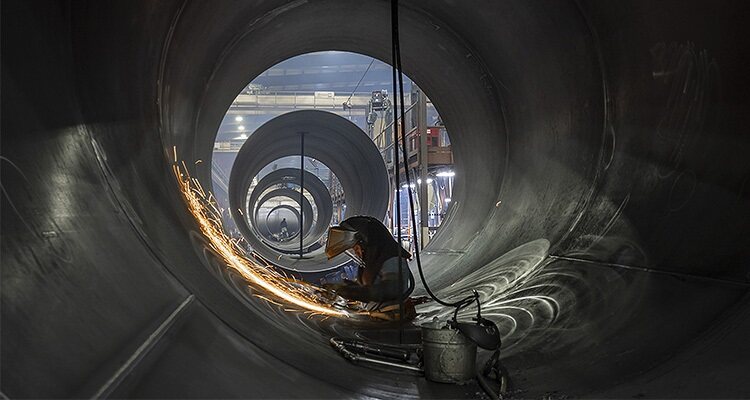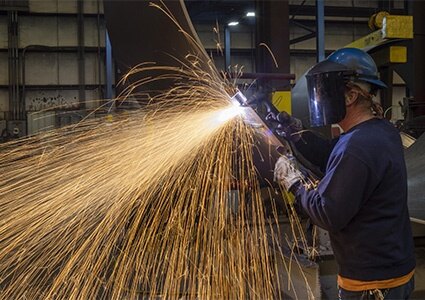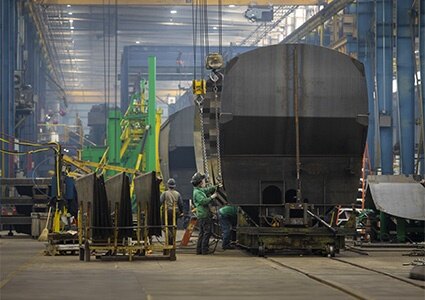
How The Greenbrier Companies is strengthening its global footprint while exploring the future of railcar transport
The Greenbrier Companies (Greenbrier) is a global leader in rail freight equipment and services, with specific expertise in the production, refurbishment, and management of railcars. Tracing its roots to a steel fabrication company formed in 1919 in Portland, Oregon, Greenbrier has since grown to produce, sell, and lease railcars all over the world, powering the movement of essential products around the world.
Based in Lake Oswego, Oregon, Greenbrier is dominant in the North American freight market. It has expanded to manufacturing plants in Mexico too, boosting its annual production capacity to 25,000 units. Further afield, the company also occupies both office and manufacturing space in Europe, as well as in Brazil, enabling it to provide manufacturing and repair services, as well as freight railcar sales and leasing across the three continents.
 With an extensive network and an impressive legacy to discuss, we sit down with Greenbrier’s Vice President of Operations, Tony Warwick, who shares his personal experiences of working in the business, as well as the strategy behind the company’s recent operations and what to expect in 2024.
With an extensive network and an impressive legacy to discuss, we sit down with Greenbrier’s Vice President of Operations, Tony Warwick, who shares his personal experiences of working in the business, as well as the strategy behind the company’s recent operations and what to expect in 2024.
“Greenbrier has evolved greatly since Bill Furman formed a business to start building container cars in Portland, Oregon,” Tony opens. “As the business grew, it diversified to manufacture various other types of railcars to cater to evolving demands. Our geographical footprint also grew, and the business eventually came to manufacture several North American railcar types.”
Its vast portfolio includes auto carriers, boxcars, centerbeams, covered hoppers, flatcars, gondolas, intermodal units, open-top hoppers, and tank cars. Tony elaborates: “We build railcars that transport just about anything you have in your home, or the commodities that we rely on day-to-day. Railcars are used to transport shipping containers, and we manufacture nearly every car type that you might see on the rail, from standard boxcars to specialized tanks for transporting liquids and gases.
Optimizing customer experience
“One thing that surprised me when I first joined the rail industry was how many distinct types of tank cars there are. The vast number of variations still amazes me, as there’s different size combinations, safety features, commodities, valves, and so on, which all have their own nuances that make them unique.
“We refer to orders as ‘lots,’ so one lot could be made up of five cars, ten cars, or even 1000 cars,” he continues. “When we start working on a lot, we typically present the first railcar for inspection by the customer. With the customer’s input, we then make any necessary changes during the production run. During the pandemic, we lost the ability to meet in person, so we developed an innovative way to conduct inspections virtually.
“We worked with our corporate IT group to develop our Virtual Sample Railcar service. We incorporated videos of the car at various stages of the production process and provided close-up photos of the key components, which are then sent to the customer for review. Customers appreciated the flexibility, so we’ve kept the process in place. In fact, we’re still predominantly virtual, with around 70-to-80 percent of these sample car meetings taking place online.”
As Tony outlines, the Virtual Sample Railcar service remotely brings a customer inside the plant to inspect the quality of their sample railcar. Designed around optimizing customers’ experience, this service has gained attention from around the globe, winning awards in the US and Canada and being featured in several industry publications.
Fleet visibility
Aside from manufacturing, Greenbrier also offers several services, including railcar maintenance and management solutions. The company maintains one of the largest refurbishment service networks in North America, offering expert maintenance services, cushioning units, wheels, truck components, and aftermarket support across its network of strategically located full-service repair centers.
With more than 400,000 railcars in its management portfolio, the company’s management solutions help customers better manage freight costs and improve uptime. It also offers custom services to meet specific requirements like technical services or logistics support.
Greenbrier is also a partner in a consortium of rail-related businesses that are pursuing the development of a new rail telematics platform. RailPulse uses real-time data transmissions and algorithms to track the location, condition, and health of any North American railcar. This enables fleet managers greater visibility over not only the track-level location of the railcar, but also the status of the car in terms of the load, temperature, moisture, and any other onboard sensors, as well as the mechanical health of the car like its bearings, bolsters, and components.
Sustainable solutions
Considering sustainability, Greenbrier also offers a Sustainable Conversions service, providing an efficient and cost-saving option for railcar owners to diversify and optimize their fleets as they strive to hit sustainability goals. Through rebody and stretch programs, it can convert covered hopper fleets into other service uses, often using existing components to reduce the overall cost.
Embracing diversity
Turning to the company’s people, Tony states: “Our workforce is our lifeblood. The company’s overall success depends on our employees, so I constantly aim to develop a strong leadership team. However, the problem of skills shortages is particularly challenging. Jobs at our plants in Mexico, for example, are in high demand, with multiple people waiting for a limited number of jobs, whereas jobs based at our US plants are incredibly difficult to fill.
“It doesn’t stop once we’ve recruited new talent, as we’re then challenged with retaining those people. We’re always on the lookout for innovative ways to keep our employees engaged in their jobs. One of the ways we try to retain people is by creating a positive working culture based around our four core values – safety, quality, respect for people, and customer satisfaction.
“We’ve also embraced what we call our IDEAL commitment, which stands for inclusion, diversity, equity, access, and leadership,” he details. “This reflects our emphasis on promoting a positive culture, as we want our people to feel safe, respected, engaged, motivated, and valued for their contributions to our overall success. We embrace diversity and expect nothing but fair and respectful treatment for all people, eliminating any biases or stereotypes that could otherwise be barriers to opportunities and employment advancements. To ensure accessibility, we ensure our processes have multiple entry points and equip our staff with the resources required to get a job done well.
Prioritizing quality
“The last pillar, ‘leadership,’ refers to the commitment our leadership team makes by placing these values at the core of everything they do. IDEAL is not a campaign or project with a finish date, but rather an ongoing initiative to foster an inclusive and equitable workplace. To provide mentorship programs or simply advice for our employees, we’ve created employee research groups. ‘Emerging Leaders’ was established to guide individuals entering the workforce or the rail industry and ‘Second Chance’ was implemented to help employees who’ve been impacted by the criminal justice system.”
With a renowned global reputation, Greenbrier must ensure it consistently delivers exceptional quality alongside friendly customer service. “We simply must prioritize quality to provide superior railcars with no defects and an extensive warranty to cover potential future problems,” Tony elaborates. “To sustain this, we have to regularly check that our equipment is optimized and the plants themselves are well maintained.
“We try to stay aware of the latest technological advancements to enhance our efficiency. We’re preparing to implement robotics at our facility in Jackson, Mississippi, for example, which we anticipate will equate to the workload capacity of 16 employees. There have been concerns in the past that robotics will be used to replace people, but with the current labor shortages, robotics are now almost a necessity to supplement our workforce. As these robots will carry out welding, their implementation will also alleviate repetitive tasks for our employees.”
A hybrid approach
On the topic of investment, Tony reveals Greenbrier’s commitment to plants in both North America and Mexico. “We have a total of five railcar manufacturing sites in North America – two in the US and three in Mexico,” he says. “Through our site visits, we’ve been sharing best practices with our teams. In Mexico, we’re now building a facility to specifically insource parts in Mexico to support manufacturing operations throughout the region.”
As our conversation draws to a close, Tony shares his thoughts on the evolution of the industry. “The railcar market is typically cyclical, based on a seven-to-eight-year cycle driven by the state of the global economy. So, we’re challenged with finding ways to retain business even in downturns. One of the things we’re doing is embracing what we call a hybrid approach, where we take existing cars and put them through our requalifying program to inspect the valves and integrity of the steel. This keeps them on the rail, allowing them to continue in operation as opposed to building entirely new cars.
“Although we’re increasingly seeing more requalifying activity, our biggest challenge over the next few years is fully transitioning our operations and plants from new car facilities to hybrid ones that can not only manufacture cars but also effectively requalify existing ones,” Tony concludes. “Overall, we’ll continue to prioritize delivering high-quality railcars to our existing customers in North America and across the globe.”